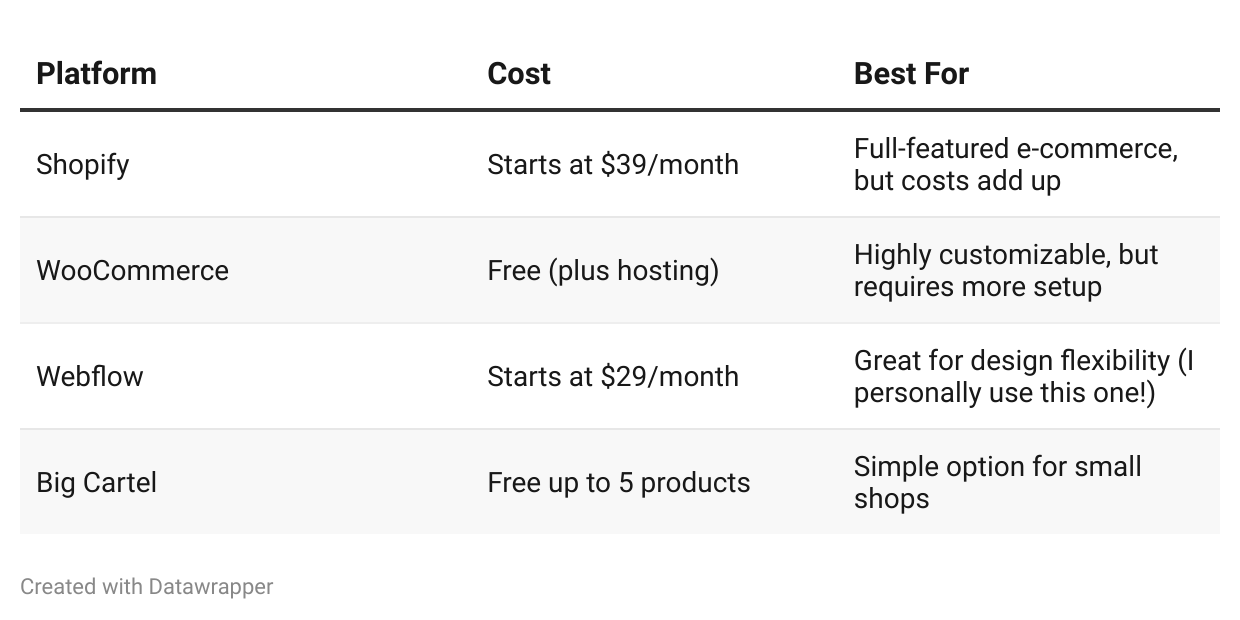Making the Leap: Moving from Etsy to Your Own Website
Wade Into the Website Waters Without Drowning in Tech Regret
Etsy is like renting a booth at a bustling craft fair—great for getting foot traffic, but expensive and full of rules. And just when you start getting comfy, they hike the booth rent, move your shop to a dimly lit corner, and introduce a new algorithm that favors mass-produced junk over your lovingly handcrafted work.
Owning your own website, on the other hand, is like running your own boutique. No random rule changes. No surprise fees. No fighting for visibility. But there’s a catch—you have to get people to walk through the door.
That’s why you don’t want to jump in headfirst and risk drowning in website overwhelm. Instead, you’ll take it step by step, starting with a simple one-page site before turning it into a full-blown shop. By the end of this guide, you’ll have a clear roadmap for making the switch without losing your mind (or your sales).
If you're short on time, check out Just the Facts, Ma’am for a quick breakdown. Otherwise, grab a snack, and let’s get started!
Just the Facts, Ma’am: Quick Guide to Moving from Etsy to Your Own Website
Short on time? Here’s the TL;DR—click any section to hop straight to the details.
🔹 Step 1: Start with a One-Page Website – First, pick a platform (WordPress + WooCommerce, Shopify, Webflow, etc.), then launch a simple one-page site to claim your space.
🔹 Step 2: Set Up an Email Marketing System – Etsy hoards your customer data like a dragon guarding treasure. Start collecting emails so you own your audience.
🔹 Step 3: Expand Your Website with Essential Pages – Add pages like About, FAQs, and Custom Orders to create a solid foundation.
🔹 Step 4: Turn Your Site into an Online Store – When you’re ready, set up e-commerce functionality so customers can buy directly from your site.
🔹 Maintaining Your Etsy Shop During the Transition – Keep Etsy running while directing buyers to your new home.
🔹 Final Touches: Driving Traffic & Growing Your Sales – SEO, social media, and email marketing are your new best friends.
🚀 Bottom Line: You don’t have to move everything overnight—ease in and build as you go!
Step 1: Start with a One-Page Website
Before you even think about building your website, you need to choose your platform. Think of this like picking the foundation for your dream house—you don’t want to lay bricks only to realize you’re building on a sinkhole.
Popular Website Platforms for Selling Online
💡 Important Note: WooCommerce isn’t a standalone platform—it’s an add-on for WordPress. So if you choose it, you’ll also need WordPress hosting (like SiteGround or WP Engine).
Now, Let’s Get That One-Page Website Live
If the idea of building an entire website makes you want to crawl under a blanket and pretend the internet doesn’t exist, don’t worry—you only need one page to start.
At this stage, your website’s job is to exist. That’s it. You just need a single page that introduces your brand and gives people a way to reach you.
What to Include:
✔ Your business name & branding – A logo, colors, and a simple tagline.
✔ A short introduction – Who you are, what you sell, and why customers should care.
✔ A contact form – Let people ask about custom orders or restocks.
✔ Links to your Etsy shop & social media – Keep traffic flowing while you transition.
This isn’t about perfection—it’s about planting your flag in the digital ground.
Step 2: Set Up an Email Marketing System
Right now, Etsy owns your customer list. If they ban your shop tomorrow (which has happened to plenty of sellers for no reason at all), you lose everything—your buyers, your revenue stream, your will to live.
This is why email marketing is a game-changer.
At this stage, your goal is simple: start collecting emails.
How to Get People to Sign Up
Nobody joins an email list just for fun. You have to give them a reason. Some ideas:
✔ Exclusive discounts – 10% off their first order if they sign up.
✔ Early access to new products – Make them feel special.
✔ Behind-the-scenes content – Sneak peeks, work-in-progress shots, or personal updates.
Once you have their email, you can build relationships and bring them back to your shop—no algorithm required.
Step 3: Expand Your Website with Essential Pages
Now that your website exists, it’s time to make it more functional.
Key Pages to Add:
✔ About Page – Share your story and help customers connect with you.
✔ FAQ Page – Reduce repetitive questions by answering them upfront.
✔ Gallery or Portfolio – Show off your best work with high-quality images.
✔ Custom Order Request Form – If you’re not ready for full e-commerce, let customers place special requests.
These pages help build trust—which is crucial when selling online!
Step 4: Turn Your Site into an Online Store
Now comes the big leap—actually selling on your own site.
✔ Choose your e-commerce platform (Shopify, WooCommerce, or Webflow).
✔ Upload your best-selling products first—no need to list everything right away.
✔ Set up payment processing (Stripe, PayPal, etc.).
✔ Test everything before launching!
By this stage, your website is officially your shop, not just a placeholder. 🎉
Maintaining Your Etsy Shop During the Transition
Keep your Etsy shop open and use it to funnel traffic to your new site.
Your Two Options:
✅ Leave Etsy Active – Add a shop announcement that says, “Find exclusive designs & better deals on my new website: [YourSite.com]”
✅ Use Holiday Mode – If you need a break, set your shop to Holiday Mode with a note about your new site.
Etsy is still useful as a marketing tool—just don’t let it be your only source of sales.
Final Touches: Driving Traffic & Growing Your Sales
Your website isn’t a Field of Dreams—just because you build it doesn’t mean people will come. You have to drive traffic.
✔ SEO (Search Engine Optimization) – Optimize your site for Google so new customers can find you.
✔ Social Media Marketing – Keep posting and directing people to your website.
✔ Email Marketing – Regularly update subscribers with new products, sales, or stories.
Your website is your new handmade empire. Now, you just need to get people through the doors.
💬 Need Help Making the Leap? Let’s Chat!
Feeling overwhelmed or just want a second opinion before you start dipping your toe into the website waters? Schedule a free 20-minute Google Meet session with me—I’ll help you figure out your next best step (and promise not to throw too much tech jargon at you).



